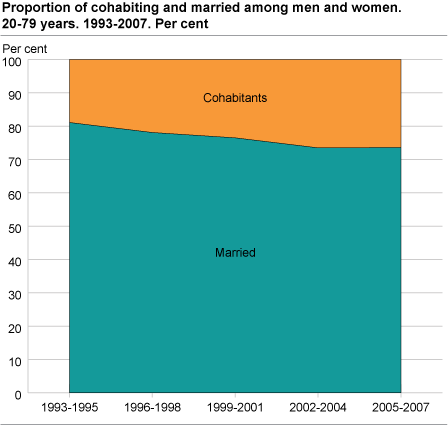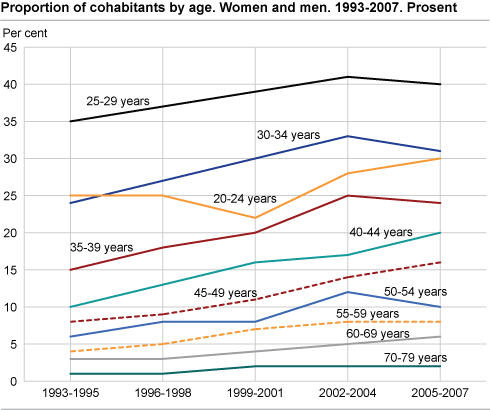Content
Published:
This is an archived release.
Stable cohabitation figures
The proportion of cohabitants in relation to all couples has not increased in recent years. Cohabitation is most common among persons between 20 and 40 years of age. Young women in their twenties are more likely to cohabit than men at the same age.
The proportion of cohabitants in relation to married couples is one in four. This is unchanged from the last survey, which was carried out in 2002-2004. In the period 1993-1995, about one in five was cohabiting. The figures above include women and men age 20-79.
Until 2004, there was an increase in the proportion of cohabitants in most age groups for both women and men. Up to the mid-1980s there was an increase in all age groups except young women (20-24). Since then the figures for most age groups have become more stable.
According to interview data from 2003-2004, the proportion of cohabitants continues to increase in most age groups. The total number of cohabitants is estimated to about 300 000 couples. This is a higher estimate than figures based on registers. Stricter requirements with regard to legal residence address imply that cohabitants must have the same residence address in order to be classified as cohabitants in the register based statistics, as opposed to interview surveys.
|
The statistics are based on surveys and whether a person is defined as a cohabitant or not depends on information given in the survey interview. Experience shows that statistics based on registers and legal residence address result in fewer cohabiting couples than statistics from surveys based on interviews and place of usual residence. |
Tables:
Contact
-
Ane Margrete Tømmerås
E-mail: ane.tommeras@ssb.no
tel.: (+47) 91 99 29 62
-
Anders Sønstebø
E-mail: anders.sonstebo@ssb.no
tel.: (+47) 46 66 37 74
-
Statistics Norway's Information Centre
E-mail: informasjon@ssb.no
tel.: (+47) 21 09 46 42


